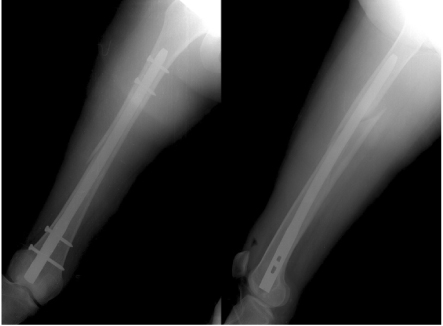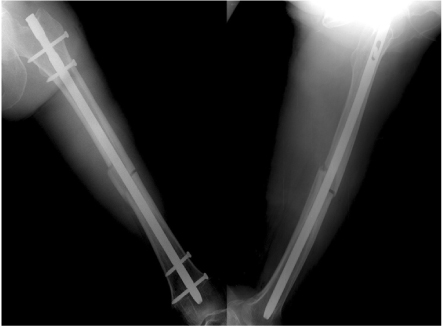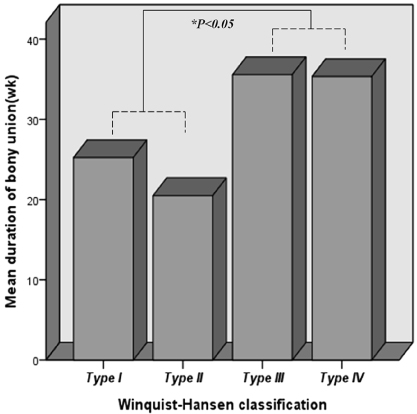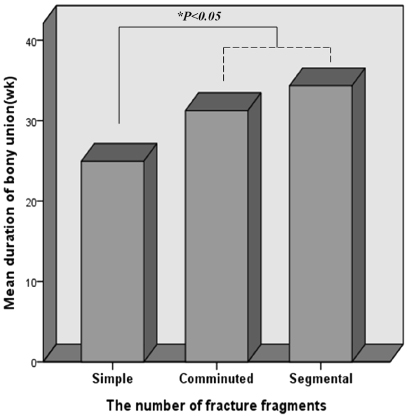J Korean Fract Soc.
2011 Oct;24(4):313-320.
Analysis of Risk Factors for Nonunion after Intramedullary Nailing of Femoral Shaft Fracture in Adult
- Affiliations
-
- 1Department of Orthopedic Surgery, Sanggye Paik Hospital, College of Medicine, Inje University, Seoul, Korea. ybs58@paik.ac.kr
Abstract
- PURPOSE
To evaluate the union time and nonunion rate after intramedullary nailing of femoral shaft fracture in adult, we would like to analysis the operation techniques, comminution, contact surface and displacement.
MATERIALS AND METHODS
We reviewed retrospectively 53 patients undergoing femoral intramedullary nailing at least 2 years postoperatively and analysised the union time and nonunion rate by operation techniques, comminution, contact surface and displacement. Patients were operated by either antegrade or retrograde intramedullary nailing.
RESULTS
There were no differences in nonunion rate, the duration of bony union between antegrade and retrograde intramedullary nail groups. Significant differences were found in the duration of bony union between the Winquist and Hansen type I, II and the type III, IV (p<0.05). There were significant differences in the duration of bony union among simple, comminuted, and segmental fracture groups (p<0.05).
CONCLUSION
The union time is affected by not operation techniques and fracture displacement, but Winquist-Hansen classification and number of fracture fragments in intramedullary nailing of adult femoral shaft fracture.
MeSH Terms
Figure
Reference
-
1. Brumback RJ, Uwagie-Ero S, Lakatos RP, Poka A, Bathon GH, Burgess AR. Intramedullary nailing of femoral shaft fractures. Part II: Fracture-healing with static interlocking fixation. J Bone Joint Surg Am. 1988. 70:1453–1462.
Article2. Harley BJ, Beaupre LA, Jones CA, Dulai SK, Weber DW. The effect of time to definitive treatment on the rate of nonunion and infection in open fractures. J Orthop Trauma. 2002. 16:484–490.
Article3. Hwang SK, Han JB. Treatment of femur shaft fracture by intrlocking intramedullary nailing. J Korean Orthop Assoc. 1995. 30:395–402.
Article4. Karadimas EJ, Papadimitriou G, Theodoratos G, Papanikolaou A, Maris J. The effectiveness of the antegrade reamed technique: the experience and complications from 415 traumatic femoral shaft fractures. Strategies Trauma Limb Reconstr. 2009. 4:113–121.
Article5. Kempf I, Grosse A, Beck G. Closed locked intramedullary nailing. Its application to comminuted fractures of the femur. J Bone Joint Surg Am. 1985. 67:709–720.
Article6. Kim SS, Sohn SK, Kim CH, Lee MJ, Wang L. Cause and treatment of the nonunion of femoral shaft fracture after interlocking intramedullary nailing. J Korean Fract Soc. 2007. 20:141–148.
Article7. Kuentscher G. Intramedullary surgical technique and its place in orthopedic surgery. J Bone Joint Surg Am. 1965. 47:809–818.8. Lee SH, Lee JY, Ha SH, Sohn HM, Lee KC. Treatment of Distal Femoral Shaft and Supracondylar Fracture with a Retrograde Intramedullary Nailing. J Korean Fract Soc. 2004. 17:103–109.
Article9. Lee SW, Kwun KW, Kim SK, Choi CH, Chang HS. Closed interlocking nailing for femoral shaft fracture - comparison of results according to fracture comminution and site. J Korean Soc Fract. 1998. 11:528–532.
Article10. Lee WS, Shin KH, Lim KS. Nonunion after intramedullary nailing of femoral shaft fracture. J Korean Soc Fract. 1999. 12:577–583.
Article11. Meyer RW, Plaxton NA, Postak PD, Gilmore A, Froimson MI, Greenwald AS. Mechanical comparison of a distal femoral side plate and a retrograde intramedullary nail. J Orthop Trauma. 2000. 14:398–404.
Article12. Moed BR, Watson JT. Retrograde nailing of the femoral shaft. J Am Acad Orthop Surg. 1999. 7:209–216.
Article13. Morgan E, Ostrum RF, DiCicco J, McElroy J, Poka A. Effects of retrograde femoral intramedullary nailing on the patellofemoral articulation. J Orthop Trauma. 1999. 13:13–16.
Article14. Murray P, Bergin P, Labropoulos P, Gunther S. Retrograde femoral nailing and knee function. Orthopedics. 2008. 31.
Article15. Noumi T, Yokoyama K, Ohtsuka H, Nakamura K, Itoman M. Intramedullary nailing for open fractures of the femoral shaft: evaluation of contributing factors on deep infection and nonunion using multivariate analysis. Injury. 2005. 36:1085–1093.
Article16. Ostrum RF, Agarwal A, Lakatos R, Poka A. Prospective comparison of retrograde and antegrade femoral intramedullary nailing. J Orthop Trauma. 2000. 14:496–501.17. Pritchett JW. Supracondylar fractures of the femur. Clin Orthop Relat Res. 1984. 184:173–177.
Article18. Ricci WM, Bellabarba C, Evanoff B, Herscovici D, DiPasquale T, Sanders R. Retrograde versus antegrade nailing of femoral shaft fractures. J Orthop Trauma. 2001. 15:161–169.
Article19. Sanders R, Koval KJ, DiPasquale T, Helfet DL, Frankle M. Retrograde reamed femoral nailing. J Orthop Trauma. 1993. 7:293–302.
Article20. Scheerlinck T, Krallis P, Descamps PY, Hardy D, Delincé P. The femoral supracondylar nail: preliminary experience. Acta Orthop Belg. 1998. 64:385–392.21. Shon OJ, Lee WJ. Analysis of prognostic factors for union time after unreamed femoral nailing. J Korean Fract Soc. 2004. 17:13–18.
Article22. Song KW, Lee SY, Shin SI, et al. Retrograde intamedullary nailing for femoral fracture. J Korean Fract Soc. 2006. 19:314–318.
Article23. Sung YB, Park SC, Ahn JK, et al. Long term results of retrograde nailing in adult femoral shaft Fractures. J Korean Soc Fract. 2002. 15:356–362.
Article24. Taitsman LA, Lynch JR, Agel J, Barei DP, Nork SE. Risk factors for femoral nonunion after femoral shaft fracture. J Trauma. 2009. 67:1389–1392.
Article25. Tornetta P 3rd, Tiburzi D. Antegrade or retrograde reamed femoral nailing. A prospective, randomised trial. J Bone Joint Surg Br. 2000. 82:652–654.26. Winquist RA, Hansen ST Jr, Clawson DK. Closed intramedullary nailing of femoral fractures. A report of five hundred and twenty cases. J Bone Joint Surg Am. 1984. 66:529–539.
Article27. Won CH, Kang SB, Shin K, Jeon KC, Yoo JS, Jang KH. Treatment of femoral shaft fractures with static interlocking intramedullary Nailing. J Korean Soc Fract. 1995. 8:533–537.
Article28. Yoon JH, Ahn BW, Kim CK, et al. Retrograde intramedullary nailing or the treatment of segmental femoral shaft fracture including distal part. J Korean Fract Soc. 2009. 22:145–151.
Article
- Full Text Links
- Actions
-
Cited
- CITED
-
- Close
- Share
- Similar articles
-
- Interlocking Intramedullary Nailing Versus conventional Kuntscher Intramedullary Nailing for Fracture of the Femoral Shaft
- Treatment of the Femoral Shaft Nonunion Occurredafter Intramedullary Nailing
- Results of Exchange Nailing in Hypertrophic Nonunion of Femoral Shaft Fracture Treated with Nailing
- The Use of Poller Screws in Nonunion of Femoral Shaft Following Intramedullary Nailing of Femoral Shaft Fracture: A Case Report
- Results and Problems of open Intramedullary Nailing of Femoral Shaft Fracture





